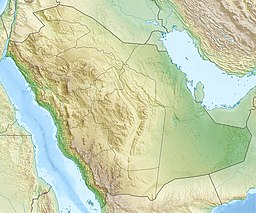| Al-Asfar Lake | |
|---|---|
| بحيرة الأصفر (Arabic) | |
 | |
| Location | Saudi Arabia |
| Coordinates | 25°31′44″N 49°48′00″E / 25.529°N 49.800°E / 25.529; 49.800 |
| Type | lake |
Al-Asfar Lake (Arabic: بحيرة الأصفر), also known as Asfar, Alasfar and Yellow Lake. Al-Asfar is located to the East of Umran city, in Al-Hasa, Eastern Saudi Arabia. The lake is surrounded by sand dunes and is somewhat difficult to reach. Al-Asfar lake is one of the most important wetland shallow lakes in the region. The lake is a historic landmark of Al-Hasa, and was mentioned by some historians of the Abbasid and Islamic Golden Era such as Al-Hamawi, Al-Qalqashandi and Al-Zamakhshari. At present, The primary source of lake water is agricultural drainage water, which makes some people refer to it as man-made. in 2019, Yellow Lake was declared national nature reserve.
History
The lake has been mentioned by several historians such as Al-Hamawi and Al-Qalqashandi. The lake is also mentioned by Al-Zamakhshari in his book "Kitab al-Amkinah wa al-Jibal wa al-Miyah ", where he describes it as peaceful lake at gates of Al-Hasa. Al-Zamakhshari suggests that the naming of the historical region of Bahrayn (which includes present time Eastern Arabia and Bahrain and translates to English as the "two Seas") comes from its location between The Green Sea and a peaceful lake at Alhasa.
Wildlife
Different parts of the lake reflect different type of shores that include Wet, moist, semi-dry and dry zones. The different zones may have different plant species. There are at least 39 plant species belonging to 20 families that can be identified around the lake. Fluctuating water level create very diverse conditions, which enhances the vegetation and plant species and types. Fluctuating water levels allow some vegetation types to regenerate from buried seeds.
Al-Asfar Lake attract migratory birds twice a year. Birds migrate from cooler places such as Russia, Canada, India and Iran to warmer climate areas including Al-Asfar Lake. The range of birds varies from small birds such as Sparrows to large birds such as geese and ducks.
Environmental concerns
The lake water is contaminated with heavy metals, which mainly comes from agricultural water. The heavy metal level is generally higher than the international permissible limits and varies seasonally.
UNESCO site
In 2018, Al-Ahsa Oasis became the fifth Saudi site to be registered as a UNESCO World Heritage Site. Al-Asfar lake is one of 12 sites that were designated as World Heritage Site within Al-Hasa.
References
- ^ "Al-Ahsa's Yellow Lake: Between the present and the future". Arab News. 2016-04-24. Retrieved 2020-12-19.
- ^ Mulḥim, Muḥammad ibn Nāṣir ibn Aḥmad.; ملحم، محمد بن ناصر بن أحمد. (1997). Tārīkh al-Baḥrayn fī al-qarn al-awwal al-Hijrī : sharq al-Jazīrah al-ʻArabīyah (al-Ṭabʻah 1 ed.). : Nādī al-Minṭaqah al-Sharqīyah al-Adabī bi-al-Dammām. ISBN 9960-736-15-6. OCLC 48570638.
- ^ الزمخشري/-/-. الجبال و الأمكنة و المياه (in Arabic). ktab INC.
- Iacoangeli, Chiara (July 2019). "Yellow Lake reservoir offers travelers natural gifts, The Arabian Sun" (PDF). Retrieved 22 December 2020.
- "البحيرة الأكبر في الخليج تتحول إلى محمية في الأحساء". العربية (in Arabic). 2019-03-09. Retrieved 2020-12-22.
- "Al-Ahsa Oasis, an Evolving Cultural Landscape". UNESCO World Heritage Centre. Retrieved 2020-12-22.